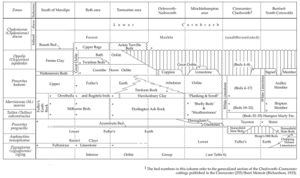Great Oolite Group, Middle Jurassic, Dorset—Somerset Province
| Green, G W. 1992. British regional geology: Bristol and Gloucester region (Third edition). (London: HMSO for the British Geological Survey.) |


Stratigraphy
The Great Oolite Group succession below the Forest Marble is conveniently described according to depositional province.
Dorset–Somerset Province
The general sequence, including the incidence of ammonites, for this province is shown in P948985 and P948998. The Mere Growth Fault appears to have been active during the early and middle parts of the Bathonian, such that the Fuller’s Earth thickens dramatically south of the fault.
Lower Fuller’s Earth
The Lower Fuller’s Earth consists of mudstones with a few thin limestones, and ranges from 35 to 55 m in thickness. The lowest 2 m or so directly overlying the Inferior Oolite comprise two units of widespread occurrence that also extend northwards into the Cotswolds province. At the base is the Fullonicus Limestone, a pale grey, fine-grained limestone which commonly includes ammonites of the uppermost subzone (P948998) of the Zigzagiceras zigzag Zone. This limestone has in times past been confused with rubbly beds at the top of the Inferior Oolite, but is distinguished from the latter by its finer-grained, non-oolitic nature. Its contact with the Inferior Oolite is commonly erosional. The Fullonicus Limestone is overlain by the Knorri Clays, characterised by the distinctive ribbed oyster Catinula knorri. The uppermost beds of the Lower Fuller’s Earth contain the sickle-shaped Praeexogyra [Liostrea] acuminata in great abundance and have locally been termed the ‘Acuminata Beds’.
Fuller’s Earth Rock
As typically developed south of the Mendips, the Fuller’s Earth Rock consists of rubbly fossiliferous grey limestones with a rich brachiopod and bivalve fauna, and moderately common ammonites. The dominant fossils are brachiopods, of which Rhynchonelloidella smithi is a common example. The formation is usually about 4 to 5 m in thickness, but may reach 11 m.
The lower part of the formation constitutes the Milborne Beds which contain ammonites of the Morrisiceras morrisi and Tulites subcontractus zones. The upper, more rubbly and argillaceous part, known as the Ornithella Beds, contains an abundance of the brachiopod Ornithella bathonica and has yielded ammonites of the early part of the Procerites hodsoni Zone. From the vicinity of Stoford southwards to Beaminster the Fuller’s Earth Rock is represented only by intermittent limestone nodules.
Upper Fuller’s Earth
The Upper Fuller’s Earth sequence is not known in detail, but it consists mostly of grey calcareous mudstones with intermittent thin limestones. It is between 8 and 15 m thick in the Sherborne area, but a much greater thickness of 41 m was proved in a borehole at Wincanton.
Frome Clay
The Frome Clay comprises about 30 m of grey calcareous mudstones including, at the base, about 5 m of fossiliferous, nodular, argillaceous limestones, known as the Wattonensis Beds after the abundance in it of the brachiopods Wattonithyris wattonensis and Rhynchonelloidella wattonensis which, however, are also found in the Fuller’s Earth Rock. Other characteristic fossils, many of which are shared with the Fuller’s Earth Rock (Rugitela Beds), include the spinose brachiopods Acanthothiris powerstockensis and various species of Rhynchonelloidella, and the curiously shaped oyster Lopha marshi. The absence of ornithellids is considered diagnostic. The beds are a valuable aid for correlation between the south-western part of the basin, where the Fuller’s Earth Rock is absent, and the remaining areas, where it is present. Its correlation with the sequences farther north is discussed below.
The Frome Clay is seldom exposed and the stratigraphical ranges of many of the brachiopods and ammonites are therefore uncertain. The main activity of the Mere Growth Fault appears to have ceased after the deposition of the Upper Fuller’s Earth; thus the Frome Clay maintains a fairly uniform thickness (P948985).